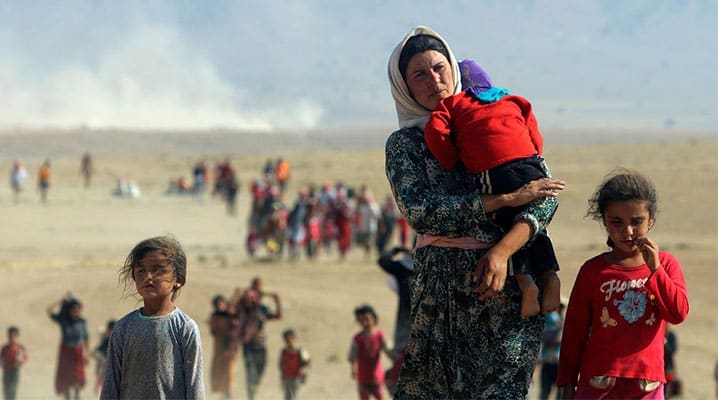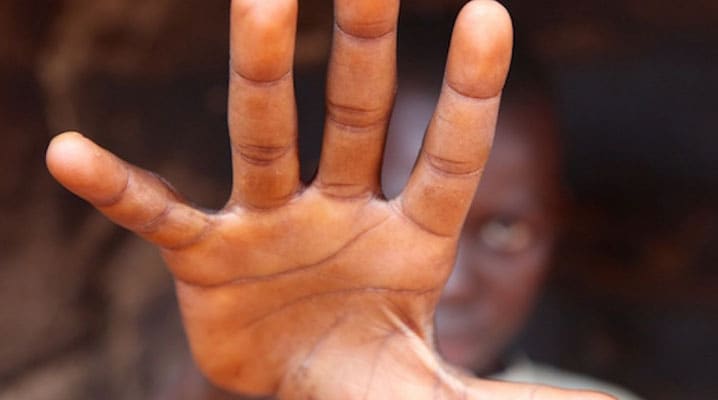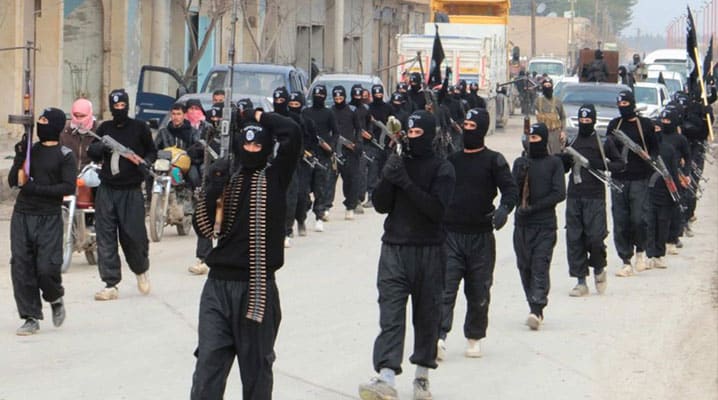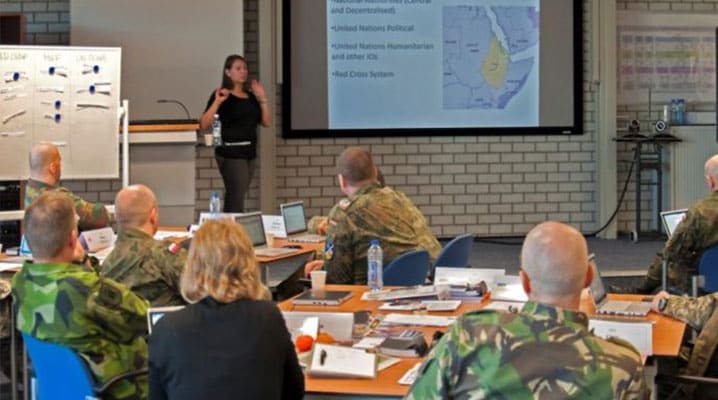To mark the 17th anniversary of United Nations Security Council Resolution 1325 on Women, Peace and Security, two experts look at how far we have come in the fight to eradicate sexual violence in conflict and at how NATO operations can be supported to enhance these efforts.
Today’s armed conflicts increasingly target civilians, exposing them to extreme violence. Civilians are caught in brutalities on the frontline of protracted conflicts in countries such as Afghanistan, the Central African Republic, the Democratic Republic of Congo, Iraq, Mali, South Sudan and Syria, where thousands become subject to one of the most brutal forms of hostilities: Conflict-Related Sexual Violence (CRSV).

Today’s armed conflicts increasingly target civilians, exposing them to extreme violence – thousands become subject to one of the most brutal forms of hostilities: Conflict-Related Sexual Violence.
The long-term destructive nature of CRSV as well as its annihilating effect on entire communities continues to pose significant threats to global peace and security. This has led to an increased expectation that actors, including NATO military personnel, operating in conflict and post-conflict settings and mandated to protect civilians, take a more prominent role in addressing this issue.
The use of sexual violence in conflicts across the globe
Sexual violence has been used as a tactic of war across the globe for centuries. Currently it is often seen as a phenomenon tormenting the African and Middle Eastern regions. However, widespread sexual violence was witnessed across Europe during the Second World War and has been acknowledged as a key aspect of the ethnic conflicts in the former Yugoslavia and Rwanda.
Also, CRSV has not diminished in today’s conflicts, as emphasised in global reporting. While many countries are affected by the threat of sexual violence, evidence of its use and impact has been broadly documented in 19 countries across Africa, Asia, Europe and South America during 2016 (see the Report of the UN Secretary-General on Conflict-Related Sexual Violence, April 2017). In addition to the official documentation in these countries, many more settings are affected by a perilous threat, occurrence or legacy of CRSV.
The use of sexual violence in conflict is today recognised, codified and prosecuted as one of the most serious violations of international law. The Law of Armed Conflict (also referred to as International Humanitarian Law) and International Human Rights Law define this type of atrocity as a war crime, a crime against humanity and, in some cases, as a component of genocide.
Conflict-Related Sexual Violence is often thought of as rape of women and girls during wartime. Yet, as defined in the Rome Statute of the International Criminal Court, the phenomenon is multifaceted and besides rape includes sexual slavery, forced prostitution, forced pregnancy, forced abortion, enforced sterilization, forced marriage and any other form of sexual violence of comparable gravity. While women and girls are indeed often the primary targets of CRSV, it is also strategically perpetrated against men and boys in its frequent aim to destroy entire communities by tearing the social fabric.

While women and girls are often the primary targets of Conflict-Related Sexual Violence, men and boys are also targeted.
In addition to including various types of grave sexual violence, the relation between CRSV and armed conflict also presents itself in different forms. It may be evident in the profile of the perpetrator or victim, a climate of impunity, cross-border consequences or in violations of the terms of ceasefire agreements (see the Report of the UN Secretary-General on Conflict-Related Sexual Violence, April 2017).
In practice, this means that CRSV is often deliberately used as a tactic of war or terror by both non-state armed groups and state security forces, as it results in physical and psychological traumas which have a devastating effect that goes far beyond the immediate victim of physical violence. Due to these long-term and relentless consequences on both victims and their communities, CRSV significantly jeopardises stabilisation efforts as well as sustainable conflict-resolution and effective post-conflict reconstruction.
Moreover, reporting on extremist and terrorist groups reveals how these groups are increasingly using sexual violence tactically as part of their operational conduct. An example of this is Daesh or so-called Islamic State operating in Iraq and Syria, using CRSV as a tactic of terrorism, torture and as part of ethnic and religious targeting. Daesh, and other extremist groups such as Boko Haram, have also used CRSV as a means of attracting and retaining combatants by promising “wives” and sex slaves to its fighters. Moreover, sexual slavery has generated large revenues for these groups, which are used to finance operations through the selling of women and girls at open markets and through collecting ransom payments from traumatised communities.
A threat to global peace and security
The threat CRSV poses to global peace and security was first recognised in United Nations Security Council Resolution (UNSCR) 1325, adopted on 31 October 2000. This resolution became the foundation of the Women, Peace and Security (WPS) agenda, that illustrated the link between peace and security and the disproportionate impact armed conflict has on women and girls.
After the adoption of UNSCR 1325, eight additional resolutions have been adopted by the Security Council as part of the WPS agenda, of which four focus specifically on CRSV: UNSCR 1820, UNSCR 1888, UNSCR 1960 and UNSCR 2106. An important clarification in these resolutions is that men and boy are also targeted. In addition, other resolutions link CRSV to other related topics such as human trafficking and violent extremism, as does UNSCR 2331 for example.

Daesh, and other extremist groups such as Boko Haram, have also used Conflict-Related Sexual Violence as a means of attracting and retaining combatants by promising “wives” and sex slaves to its fighters.
Since the WPS agenda was initiated in 2000, the nature of conflict has changed and increasingly exposes civilians to extreme and targeted violence. Simultaneously, the responsibility of protection-mandated actors to prevent and respond to CRSV has become unequivocal. This responsibility has most recently been included in NATOs guiding documents (notably in the Military Guidelines on the Prevention of, and Response to, Conflict-Related Sexual and Gender Based Violence, adopted in June 2015) through an increased emphasis on NATOs role in protecting civilians from conflict-related physical violence, or the threat of such violence.
According to NATO’s Policy for the Protection of Civilians, endorsed in July 2016, military operations shall conduct a range of activities up to and including the use of deadly force, to prevent and respond to situations where civilians suffer physical violence. The policy further states that the protection of civilians is relevant to all three core tasks of NATO: crisis management, collective defence and cooperative security. As such, through the guidance to protect civilians from physical violence, forces deployed in NATO operations today are directly tasked with combating CRSV.
Addressing CRSV in NATO operations
Protecting civilians from CRSV is a cross-cutting issue that requires a comprehensive response from military, police and civilian actors, if to be tackled effectively. Each component plays a crucial and unique role in the course of action when combating sexual violence in conflict, which needs to be thoroughly understood by all. Military personnel play a vital role in this field given their expertise in enhancing security and their duty to protect. As NATO doctrine emphasises protection from physical violence being relevant for all core tasks, this implies that combating CRSV needs to be considered in all operations and that it is a command responsibility to consider in line with all other potential threats during operational planning and execution.
The use of military actions to prevent and respond to sexual violence in conflict must be based on considerable contextual understanding and thorough actor- and threat analysis carried out during planning and execution of operations. As part of the latter analysis, the relation between security threats and vulnerable populations must be assessed. To map these relations, the following questions should be part of situational analysis:
- who is perpetrating the violence?
- against whom is the violence being committed?
- how and when is the threat-actor operating?
- what does the potential perpetrator need to play out the threat (capabilities)?
- why is the violence being committed?
- what protection mechanisms do the civilian population already use?
- which external protection counterparts are present and how should they be involved?
Challenges and the way forward
Having the responsibility to address sexual violence in conflict implies that it needs to be included in the military training and education of NATO member states when preparing for operations. The specific roles and responsibility of military personnel in terms of prevention and response to CRSV must be emphasised. This means that servicemen and women need to be trained systematically on CRSV in relation to core military tasks, including an emphasis on doctrine, mandates and rules of engagement. The use of force and preparedness to use force are a crucial aspect of this.

To be tackled effectively, protecting civilians from Conflict-Related Sexual Violence requires a comprehensive response from military, police and civilian actors. Joint and integrated training of these actors could be a good way forward. © Civil-Military Cooperation Centre of Excellence
What needs to be kept in mind is that there are many ways to protect civilians from physical violence and other threats. Military forces in operations play a crucial role in the midst of these protection mechanisms, by enhancing physical security for populations in areas affected by armed conflict. Their interaction with other relevant protection-mandated actors in the operational environment is crucial and the essential and unique role and responsibilities of the military in this mosaic of responses must be understood.
During operations, bridges need to be built and strengthened across all protection-mandated actors in order to be able to address CRSV and its numerous consequences comprehensively, as each part plays a specific and unique role in terms of prevention and response. If not addressed comprehensively, the required chain of action in the prevention and response of CRSV is broken, often implying the operation fails to adequately protect civilians from physical violence. For the military forces in armed conflict, this implies a stronger coordination with external counterparts such as international organisations, non-governmental organisations, and civil society.
As numerous actors are revising their training related to the protection of civilians, a suggested approach looking ahead is to develop joint and integrated training for military, police and civilian actors, to ensure comprehensive understanding, effective responses, and avoiding potentially doing more harm than good in already dire situations. Taking protection measures into account during training and preparation of those to be deployed to operations will ensure military forces are better prepared to effectively plan and execute operations combating CRSV. Ultimately, this can support NATO to be better equipped to achieve its goal of promoting stability in conflict areas and contributing effectively to protecting civilians.
